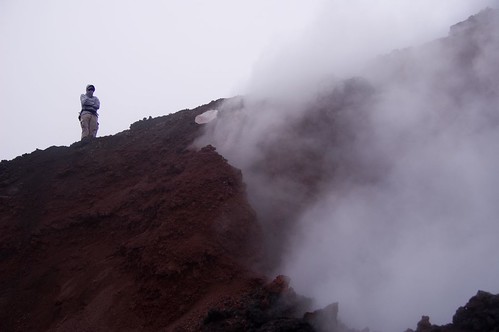
Among the very small disappointments regarding our apartment (yes, this is the apartment that is too big for us to clean ourselves, and basically has two entire rooms dedicated to storage of a few scattered items) is the view. We have a lovely view of the hills to the east, but we have only obstructed views of the three volcanoes visible from Guatemala City. However, from our balcony one can see the top of Pacaya, and of late that has included a plume of smoke rising off its peak and even a red glow faintly visible some nights. Having climbed Pacaya and other volcanoes before and having been denied any views of bubbling hot lava, your correspondent knew that the time was right for another trip -- and unlike our recently wed friends Paul and Lisa, we would not be defeated by a pile of dirt.
The climb up Pacaya is actually quite easy, but that doesn't stop enterprising local horse owners from offering rides up the top by trotting up to you on the trail and asking, "Taxi?" It's only an hour or ninety minutes of hiking to the bottom of the recent lava flow, where cows graze near a river of black rock that is a month old but still steaming in places. Another half hour gets you up to where you can see the rocks cracking and tumbling due to the lava flowing underneath. Here and there bright red spots of oozing lava would spill out of the rock, and quickly cool and turn grey. In the center of the river of rock, one could still spot a stream of constantly flowing lava running down the mountain. The staff photographer found it difficult to capture how amazing the sight was, since without the sound of rocks creaking under the stress of heat and pressure, and the motion of the lava breaking through the stones, the volcano looks a lot like a bunch of rocks. Your correspondent's attempt to translate the experience may not be much more artful, but that makes it no less true: Seeing hot lava is awesome.
For many a lava-loving tourist, this was the end of the road, but being the superbly fit and adventurous souls that we are, we continued up the sandy cone to the summit, where views were often completely obscured by the steam pouring out of various cracks in the mountaintop. But the crazy colors and rock formations resulting from sulphur deposits were also noted as "awesome."
The trip back down was much more crowded, as large groups of climbers were gathered near the lava flows. Many American tourists clambered out on the still-cooling lava, often just a few feet away from fresh flows, apparently unaware that in a Guatemalan National Park, unlike Yellowstone, there may not be a sign saying "CAUTION: DO NOT TOUCH BURNING LAVA," or even a fence to protect people from their own curiosity. The Americans were not unique in their foolishness. The majority of the crowd was Guatemalan, and they were doing the same stuff. But your correspondant, who moonlights as an ever-vigilant Vice Consul and Third Secretary, couldn't help but distinguish the two: none of the Guatemalans were going to require Embassy emergency assistance when their five-year-old fell in a stream of burning lava.
A lot of the Guatemalans seemed to be making a day of the short hike, which was a pleasure to see. There really aren't very many safe outdoor spaces in this country, so it appeared that many families were enjoying the safety of the crowds to get outdoors for a day. On the way down, we passed people carrying all manner of things up the mountain. In addition to a couple women wearing flip-flops and carrying babes-in-arms, we saw people hauling up picnic items like plastic grocery bags full of supplies, two-liter bottles of pepsi, and a boom-box blasting out some unidentified soft-rock tune from the '80s in the vein of Jefferson Starship. Those were topped by vendors carrying up baskets of tortillas, pre-made platters with chicken and rice, and one entrepreneur carrying fifty or so bags of cotton candy for sale. Just when we thought we had seen it all, we saw two women carrying between them a platter of souvenir plates reading "Volcan Pacaya" and each bearing what was presumably an actual rock from the mountain. I didn't have the heart to tell them that there were already plenty of rocks on top of the mountain, but I assume they already knew that because they had clearly been up before to carry these very rocks down in order to glue them to the little plates. Even if the letigiousness that would lead to more warning signage isn't present yet, the Guatemalans are surprisigly ahead of us in presenting National Park visitors with convenient consumer opportunities.




3 comments:
The rust spot on the sign look a lot like bullet holes to me. Pa
That's funny -- there are no guns in Guatemala...
There are nine holes and most semi-automatic hand guns hold nine rounds. But if you say there are no guns in Guatemala I believe you!!
Post a Comment